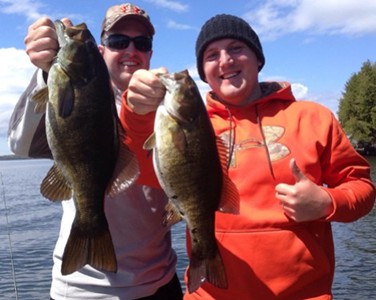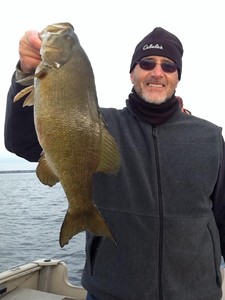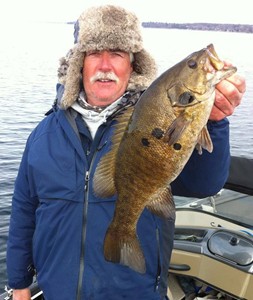Late Season Smallmouth |
October and November Bass Fishing Opportunities |
 |
|
For hardcore North Country fishermen like me, thereís nothing like a cool crisp autumn day on Lake Champlain paired with a smallmouth bass bite that is absolutely on fire! Those of us who extend our open water fishing season well beyond Labor Day find exceptional angling opportunities when the pressure from other sportsmen has eased. By October most tournament bass fishermen have moved on to warmer climates, and many other outdoor enthusiasts focus their attention on hunting. For our smallmouth bass fishery an icy dormant period approaches. During the months of October and November robust, egg laden female smallmouth are feeding heavily, stocking up on essential nutrients to see them through winter and into the spring spawn. Because of this, some of the best smallmouth bass fishing occurs in late autumn. Bronzebacks, as they are also known, are one of the best fighting fish in North America. Lake Champlain catches often average over three pounds during the late fall season, and trophy fish weighing four to five pounds or better are always a good possibility.
|
 Understanding seasonal patterns and knowing how and where to target monster smallmouth bass is crucial to an anglerís success. |
|
As the lake water temperatures drop through the 60s and 50s smallmouth bass forage actively on freshwater shrimp, crayfish and baitfish to bulk up for winter. By mid-October they begin to group up on certain rocky shoals, points and reefs around the lake. Typically these feeding grounds are adjacent to deeper water and are dependable fishing locations year after year. Fish may stage on these trustworthy spots in water as shallow as ten feet or as deep as forty feet, so covering the structure from top to bottom is critical. Once a bass is caught in a proven spot an angler should gradually, thoroughly and methodically fish the surrounding area for additional companion fish.
A go-to smallmouth application in late fall is jigging with tubes, or various other soft plastic baits. Employing a drop-shot rig can also be very productive. Smallmouth bass roam ever so slowly when water temperatures dip below 50 degrees and they rarely chase fast moving lures. Moving a jig along the bottom at a snailís pace is a very effective method as the water temperature continues to drop. Finesse is the name of the game with cold water bass. Itís an ďin their faceĒ presentation, and make no mistake; these smallmouth have a keen sense of sight. As such, they are ďline shyĒ, making light line or light leader material imperative. When itís frigid, bites may be hard to detect. Anticipation of an encounter will keep the fishermanís heart pumping, his body warm, and his mind focused. The bass may signal their presence with a slight bump, or they may subtly suck the offering up without any obvious indications other than weight on the rod tip. When a bite is detected a solid hook set is in order. The startled dormant smallmouth will suddenly come to life and the fight is on!
Itís obviously very important to be comfortable when fishing in cold weather to make the experience the best that it can be. The days are short at this time of year as the sun hangs low on the horizon. This makes for long and beautiful sunrises and sunsets, but very little heat radiation. When braving the elements of a cool autumn fishing trip an angler must dress accordingly. Dressing in layers with a wind resistant outer shell is strongly advisable. Even a light breeze on the open water can quickly draw the heat from a personís body. There is nothing worse than being out on a beautiful fall day with the fish biting aggressively and having to quit because youíre under dressed and miserably cold. |
 Hard bellied female smallmouth like this five-pounder are possible when fishing in October and November on Lake Champlain. This awesome specimen was caught in mid-November while fishing with the author. With the sun low on the horizon at this time of year anglers can expect the bite to remain hot throughout the day. |
|
Overall, Lake Champlainís smallmouth bass fishery appears to be in good shape as of this report. Recent studies by Plattsburgh State University researchers on bass migration following tournament releases indicate that smallmouth bass disperse well, and much better than their counterpart, the largemouth bass. Tournament organizations and managers are conscious about protecting the fisheries where they compete. They are continually working to educate their anglers about fish care and preventing the spread of invasive species. For the most part, I am an advocate for bass fishing tournaments. This being said, I do have concerns regarding elevated smallmouth mortality from tournaments held during the warm, deep summer months. Predation of young smallmouth bass and other small fish by the cormorant has been mitigated through more aggressive control of that nuisance waterfowl species. Managers are working toward maintaining a tolerable number of breeding pair on Lake Champlainís nesting sites. One serious threat to the smallmouth bass fishery looms. The round goby, an invasive bottom-dwelling specie from Eurasia, is already established in the Great Lakes and the Saint Lawrence River. These soft bodied fish out-compete native species like the sculpin and logperch for food. They feed aggressively on snails, fish eggs and small fish. If a smallmouth bass bed is left unguarded the majority its young can be consumed very quickly by the round goby. The decline of the smallmouth bass fishery on Lake Erie and other Great Lakes has been blamed on the invasive fish that now lives on the threshold of Lake Champlain. |
 This smallmouth caught by the author in November exhibits a condition known as hyperpigmented melanosis, more commonly called black spot, or blotchy bass syndrome. It typically appears on mature largemouth and smallmouth bass. Biologists and researchers have determined that fish with this condition are otherwise healthy and safe for consumption. |
| Bass fishing season on Lake Champlain runs from the second Saturday in June through November 30th in both New York and Vermont. There is a catch and release season in New York that runs from December 1st through the Friday prior to the opening Saturday in June. In Vermont, a similar catch and release season is allowed in the spring from the second Saturday in April through the Friday preceding the second Saturday in June. Only artificial lures are allowed during these catch and release seasons.
|
| Back to the main page |